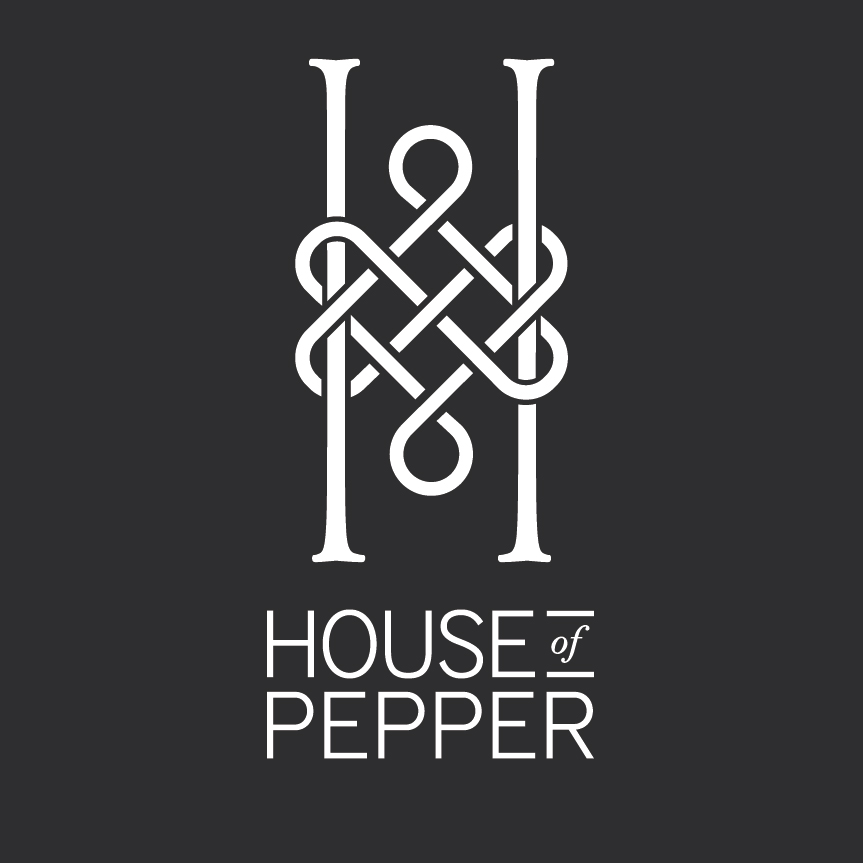Tree of Life -A Universal Icon
I have been thinking about the Tree of Life motif and how it has travelled through the centuries in cultures and artforms. The motif appears in folklore, mythology, in world religions and in philosophy. The symbolism goes back to the beginning of recorded history, the first example appearing in about 7000 BC. It is an ancient archetype, and, in our memories, it is a sacred tree.
The Tree of Life motif can be found in Art Nouveau as painted by Gustav Klimt, in Jacobean embroidery, in the idea of the World Tree and in Christianity from the Garden of Eden and in the Medieval manuscripts. All these motifs differ in their approach to the idea and image of the Tree of Life.
Tree of Life from Medieval Times
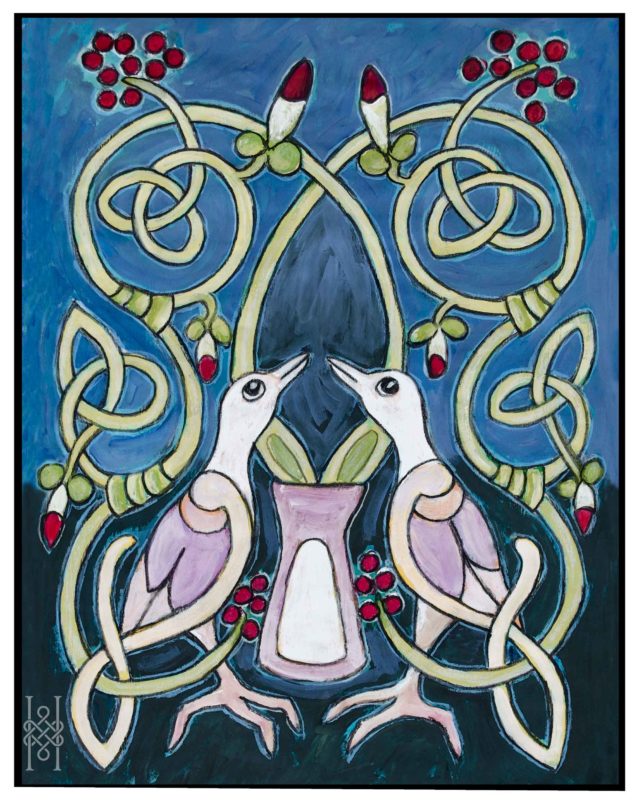
Tree of Life Book of Kells style
An extraordinary gem in the Book of Kells from Medieval times is The Tree of Life motif. It is abstract and conceptual and was created around 800 AD. This new motif came after the Lindisfarne Manuscript of 635 AD.
The monastery monks were forbidden to draw any of God’s living creatures and plants in the manuscripts and so in a brainstorm they developed a metaphor that could be read in the same way. From traditional Celtic roots the scribes and monks produced an abstract design to weave into the Gospel pages. The characteristics of the tree like the leaves, buds, flowers, and the trunk are not what we would expect. The branches of the tree reach out like tendrils, but the most incredible invention is the idea of a tree growing out of a pot or chalice. No other Tree of Life motif in my selection of motifs has diverged this far from reality.
In the first example above in the Tree of Life, the branches stretch out in a curvilinear style and the design which comes from a Dover publications label by Mallory Pearce shows trefoil leaves and berries. The design is symmetrical, two birds mirror each other. Triquetra knots and branches fill the space evenly. In all the examples the interlace is true to the Celtic knotwork style weaving over and under in a continuous line.
Book of Kells
I have also included and drawn examples from Aidan Meehan’s Celtic Design: The Tree of Life book. This artwork is adapted from his drawings taken from the Book of Kells in his book. Abstract shapes like a trumpet or cornucopia appear at the forks and represent a smaller branch growing out of the primary branch. The skittle shapes are leaves and have been altered in size to conform to the Celtic rule of weaving in and out.
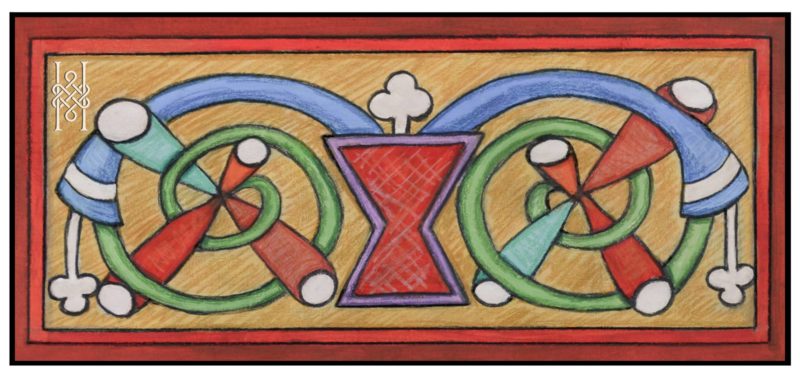
Book of Kells Tree of Life
The images below shows that the Tree of Life looks more like a vine than a tree. The vine extends and stretches outward in branches, tendrils and spirals with little trefoil leaves. There is a rhythmic flow and repetition in the underlying structure. The tree grows out of a pot like a scrolling vine.
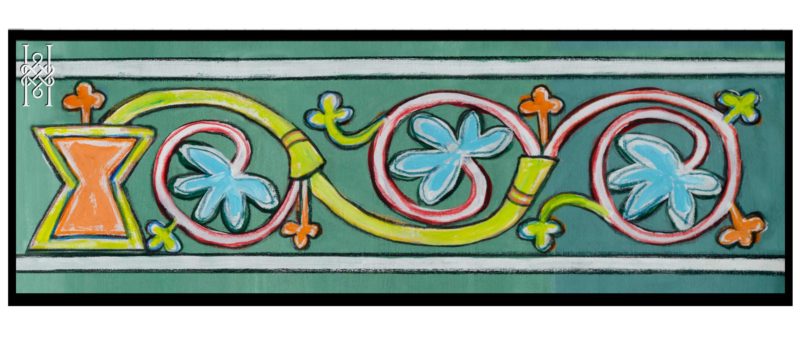
Tree of Life in a border design
George Bain, a key teacher to help interpret the visual meanings in the Book of Kells, described the Tree of Life motif as having the natural growth of a tree in logical steps from roots to leaves, and he believed it to be mistletoe rather than a vine because mistletoe grows as a plant not a clinging vine. He described the pot or chalice as holding the roots and food and wrote that during the winter months the mistletoe grew around the Oak tree. The leaves of the mistletoe, he suggests, look like lights of gold decorating the bare branches during a harsh frosty winter.
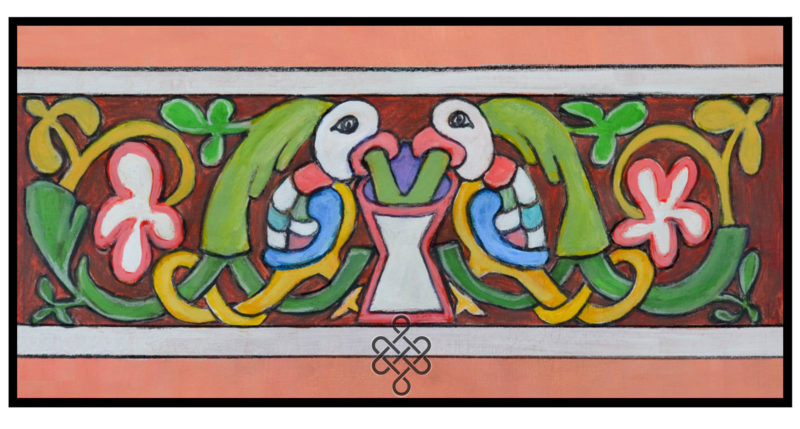
Inhabited Tree of Life with two birds from Book of Kells
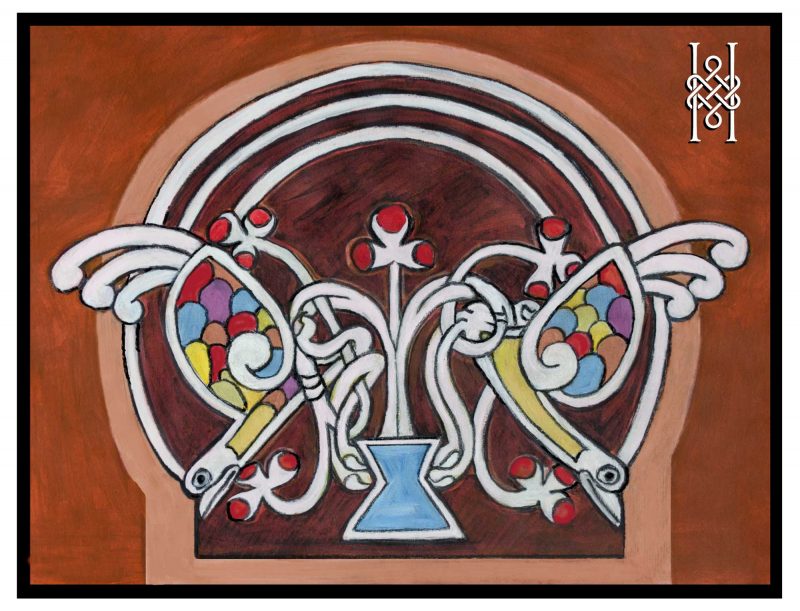
Pair of Kells birds in perfect geometric balance
These last two images show an inhabited tree. The birds mirror each other and are thought to be friends and may represent a bond between spirit and soul where one bird eats and the other watches on. The pot can represent two triangles, one inverted. It could also be a saltire or diagonal cross “X” which is another symbol of Christ.
Art Nouveau Tree of Life
One of the most memorable Tree of Life paintings from Romantic art belongs to Gustav Klimt from Austria. This beautiful Stoclet Frieze from 1905 using gold leaf is in the Art Nouveau style. The cloaked figures in relation to each other inspire a mystery or a narrative. While the mural is flat and decorative and sits forward on the picture plain, the background is empty. There is no illusion of depth as there is in the tonal renderings of Realism.
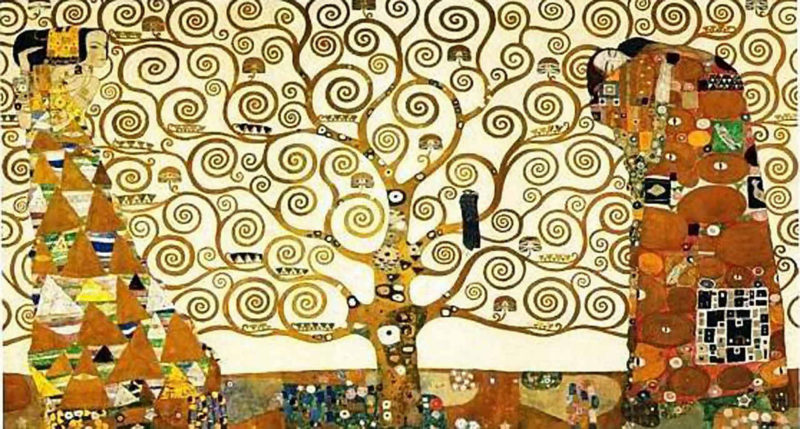
Gustav Klimt’s Tree of Life, Stoclet Frieze
Art Nouveau was an art period that began in 1890 and sought to modernize art and turn away from the Classical foundations of Realism and perspective. The inspiration was from nature and from organic curves, not, the hard straight lines of the classical columns from Ancient Greece and Rome. Gustav Klimt was a Symbolist painter interested in the metaphor and in dream symbols. He moved away from the popular mainstream as did many artists during this period. Paris became the centre of the art world with Impressionism, Post Impressionism, and other breakaway art movements.
A beautiful tree with spirals and with a black raven sitting in the middle reminds us about death in the life cycle. The big black bird is found in Norse and Celtic mythology and especially on the battle fields and in the Otherworld stories. If you look at the tree spirals you will notice that they rise above the branches, only a few are below. There are clockwise and anti-clockwise spirals, and they are single lines travelling inward.
Spirals
Noticeably in Celtic art the spirals vary and often combine more than one line or strand. Double, triple and four-part spirals are customary. In this way opposing forces can symbolize a directional flow inward and outward. The line is not closed it is left open so the flow can go back out. Spirals can look like energy fields and carry a current. Artists know that a circular spiral continuing to move inward into a vortex and closed circle, like a whirlpool creates a feeling of entrapment. Something to be avoided in paintings. The psychology is to keep the viewers eye moving and exploring round the picture, rather than to lock the eye into one spot. A whirlpool vortex is not a pleasant experience in life or in pictures.
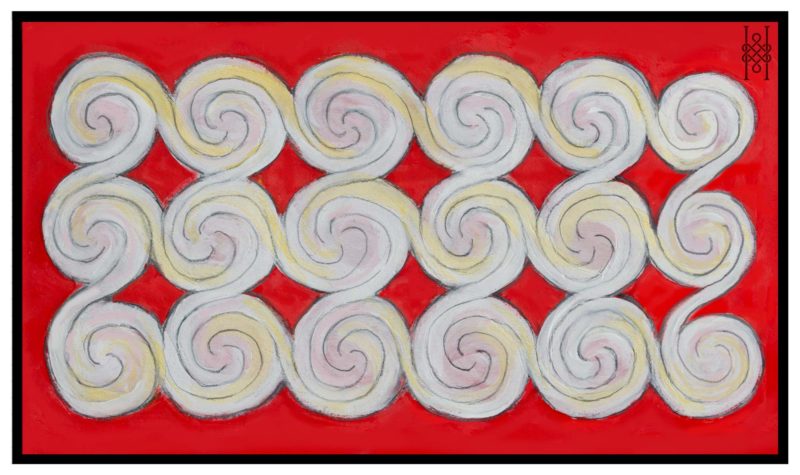
Prehistoric Spirals on Myceanaean Grave Stele
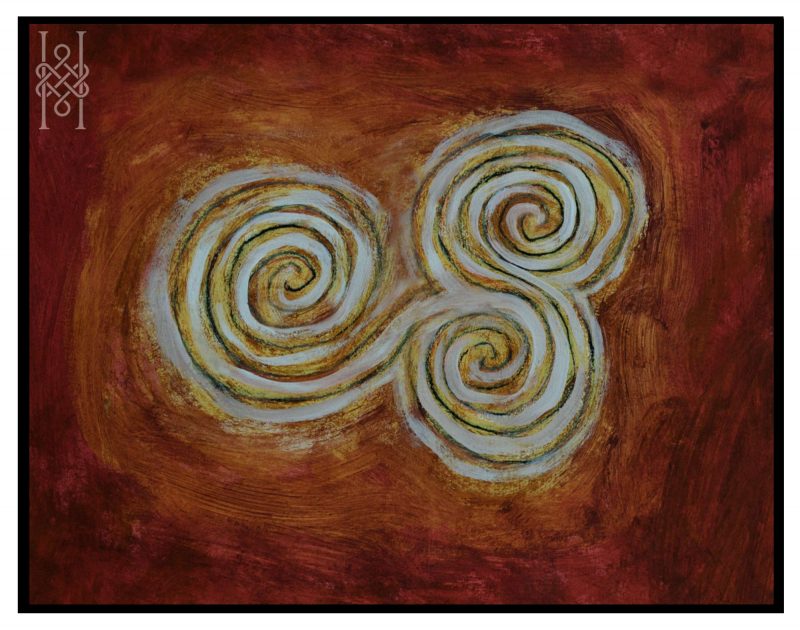
Newgrange-Stone kerbstone Triple Spiral
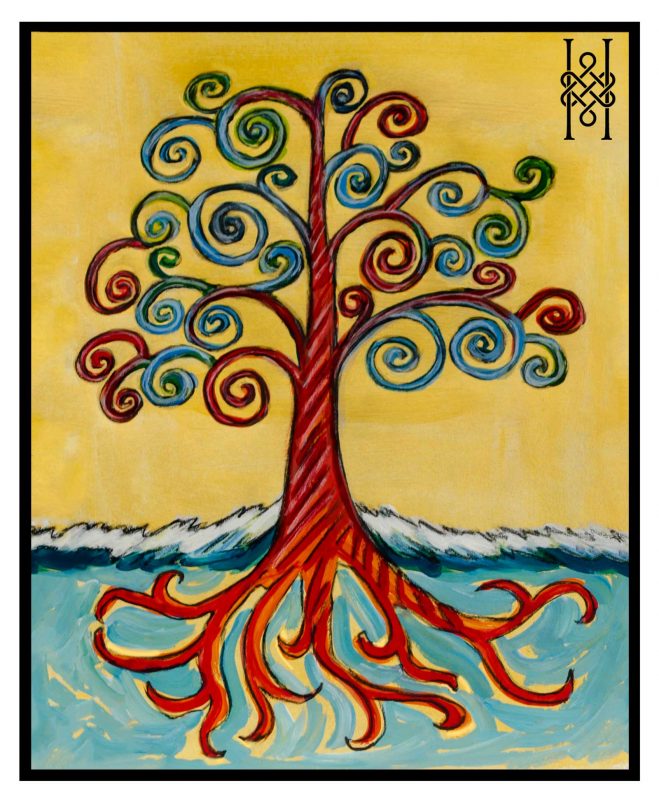
My Spiral Tree
I have included my Spiral Tree that shows balance between the branches and the roots. The red for me represents the food travelling up the trunk to the branches, just like blood circulating round the body. Red is like energy, and it is on the move, the spirals for me flow inward as the tree takes in the carbon dioxide to use for photosynthesis. We breathe out carbon dioxide which the tree breathes in. The roots dance in the soil to find water, minerals and nourishment.
Jacobean Tree of Life
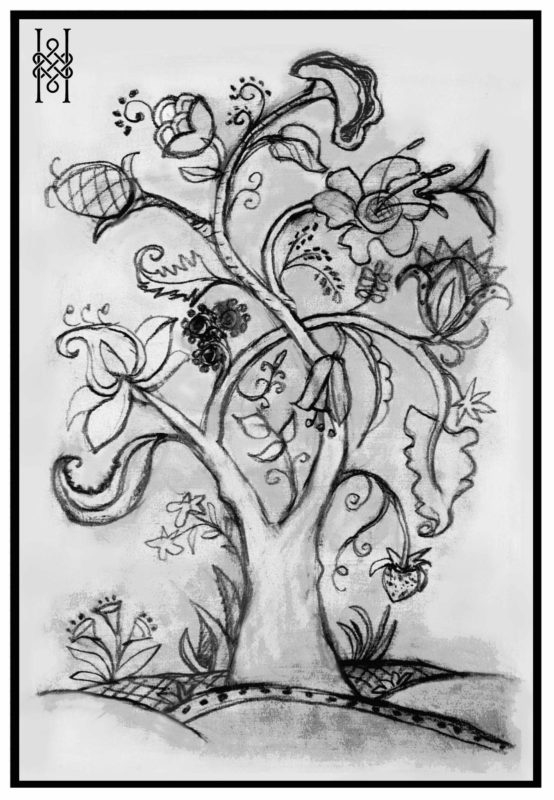
Tree of Life Jacobean
Another Tree of Life motif comes from 17th century England.
It is called Jacobean and is named after the name James from King James 1. The origin of this Tree of Life pattern can be traced back to India and to the pampalores or colourful lightweight cotton bed coverings. The pattern is a blend of European and Eastern design influences and includes exotic flowers in the mix.
The Tree of Life design was developed for fabric home furnishings and later for wallpaper designs by William Morris in England. The crewel embroidery method follows on from the Romanesque style Bayeux Tapestry of the 11th century. Crewel embroidery is worked on linen with two ply wools in a variety of stitches and spectrum colours.
This embroidery version of the Tree of Life motif has large, stylized flowers of every kind from a spring garden all on the one tree. Sometimes there are birds or animals in the design in an idyllic scene of natural simplicity found in pastoral settings. The Tree of Life Jacobean embroidery style celebrates the bounties of nature.
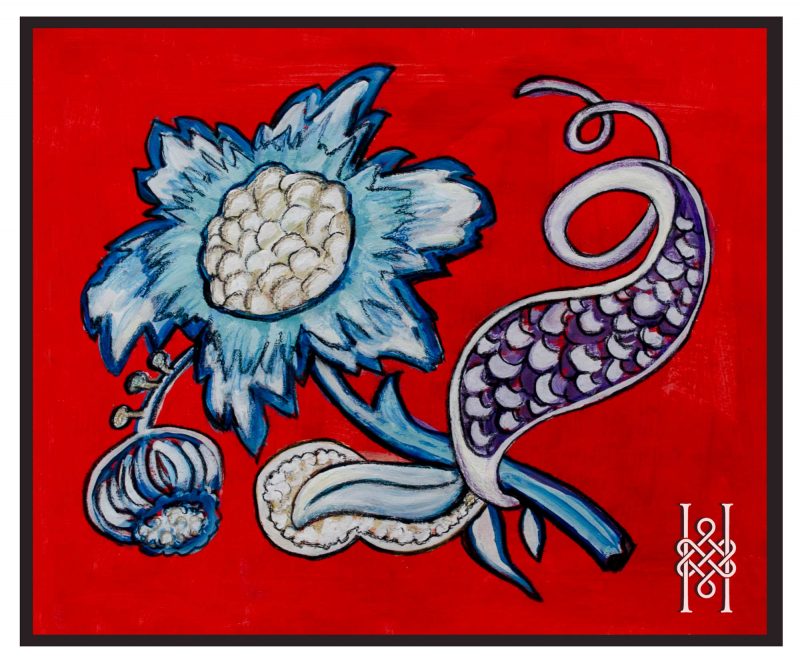
Blue Poppy design
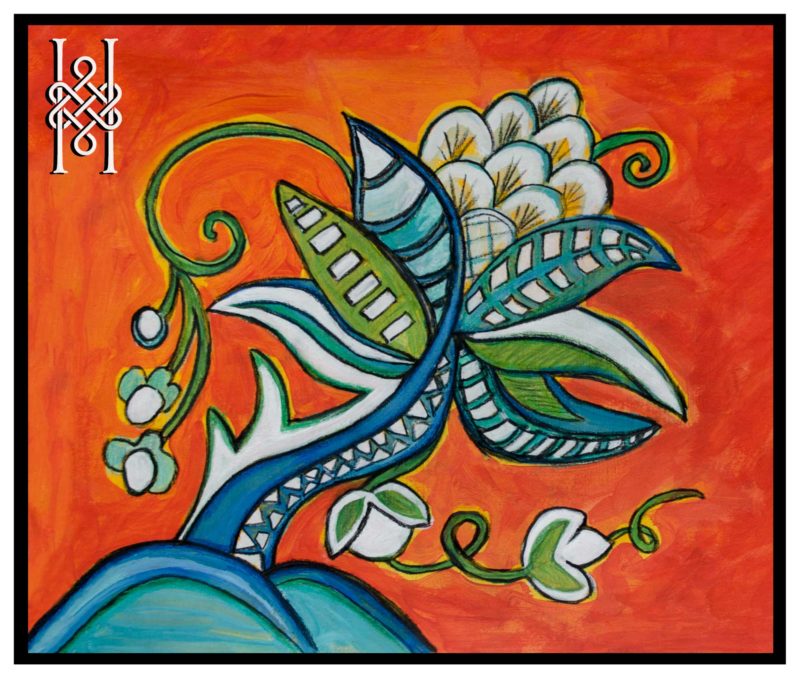
Jacobean Orange Tree
The difference between the Tree of Life in the Book of Kells and the Jacobean designs are where the anchor of the roots begins. In the Book of Kells the roots are hidden in a vase, in Jacobean crewel embroidery the tree grows from semi-circular mounds and again the roots are hidden.
We see from the Medieval Tree of Life and the Book of Kells how the Church had an impact on visual expression. For some, rules and limitations inspired new ways of seeing. The imagination of the artist can remove boundaries and find fresh solutions.
Garden of Eden Tree of Life
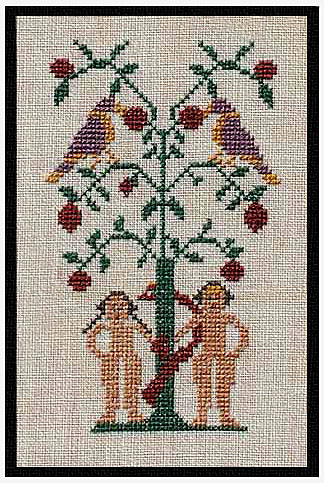
Tree of Life Garden of Eden
The Bible stories have always inspired images and one of those is the well-known Tree of Life from the Garden of Eden. In the Bible this idea first appears as a Tree of Knowledge of good and evil. Today the motif would hopefully be treated differently. The choice between good and evil already sets up an unfair premise for one gender. The two poles in Christian thinking like heaven or hell for example and good and evil have always been limited and threatening in some way.
I have included an example from a Tree of Life cross-stitch Sampler showing Adam and Eve with the apple tree and a serpent. Cross stitch Samplers date as far back as the 6th century to India and China. This Tree of Life motif like the one used in the Book of Kells, is also symmetrical and with two birds.
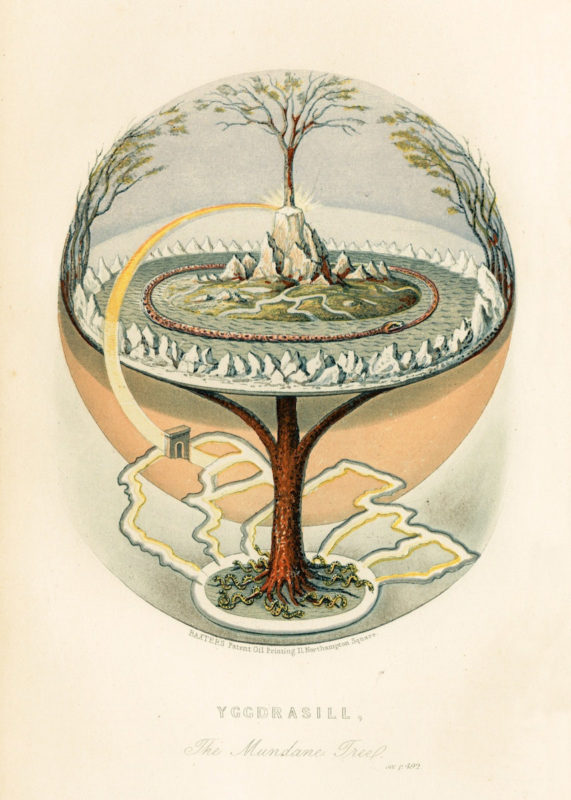
Yggdrasil World Tree 1847 Oluf Olufsenn Bagge
The World Tree
The World Tree is a symbol that immediately connects us to the cycle of life and to the great forests and jungles of the Earth and to clean air. The idea of a World Tree or Cosmic Tree is ancient and lives in many traditions and cultures.
In Norse mythology the Yggdrasil is an evergreen Ash tree with three roots named Asgara, Midgard and Niflheim. The roots are implanted deep in the Earth, and this creates cosmic stability after the World was reborn from the ashes of the old. In the Norse myth the Yggdrasil survived the Ragnarok or apocalypse.
Sometimes the Tree of Life symbol covers the entire planet as a gigantic tree connecting the Earth to the heavens. Branches reach for the stars and spread in the balloon of the outer atmosphere. The roots are shown searching and winding into the deep layers of the Earth. In the human memory this great tree carries the knowledge and wisdom of the Ages and is a symbol of life on Earth.
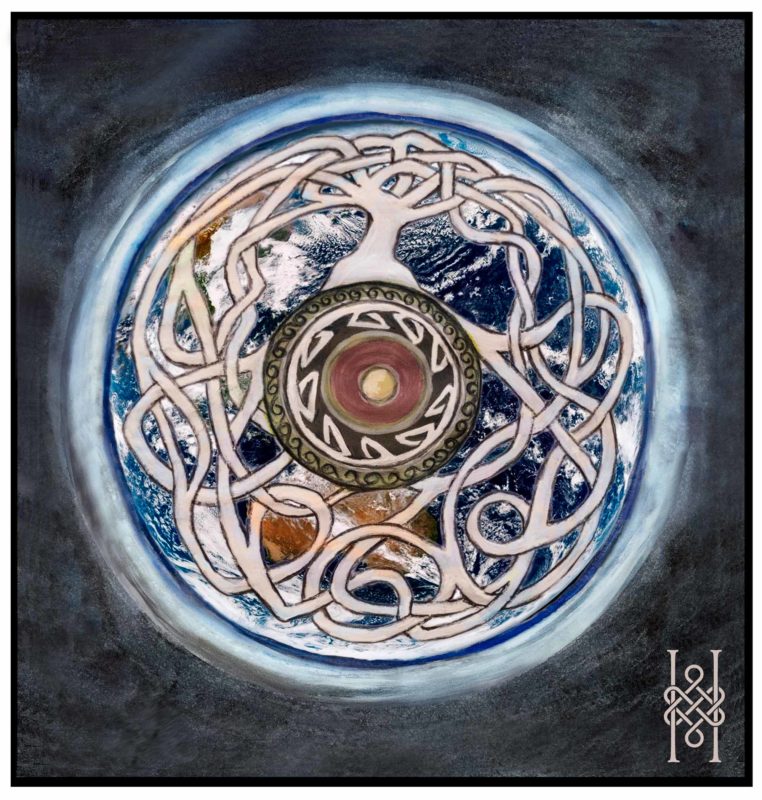
My World Tree from Space
It is a visual challenge to say the least to draw or paint such an icon. Only a three-dimensional image in space could truly capture the idea properly, a sculpture or construction hanging in space with a tree growing round it and roots inside a glass ball inside that could work.
This is my attempt at an image of a World Tree in two dimensions on a flat plain. A computer screen is a 2D flat plain.
I have stayed with the Celtic method, interlaced the branches, and placed the tree over the Earth image as seen from Space by the astronauts.
The circular disc at the centre began as a design for the roots but ended up on the outside, the frustrating limitations of my drawing skills! This makes the whole design look like a circular shield with a convex umbo in the centre. I decided to keep it and let an imaginary Celtic Shield act as a protective barrier over the Earth.
The Oak Tree
The World Tree is sometimes an Oak in European memory because it reminds us of the great forests that once covered Europe. The tree provides food, fuel, and shelter and in myth and legend symbolizes life and is associated with the wisdom and time of the Druids. The Druids loved and honoured the Oak tree as a symbol of power and strength. In the Celtic pagan life, the Oak had a strong association with the Green Man and Cernunnos- God and guardian of the forest. The Oak tree in Christian faith is sometimes seen as a symbol of Christ.
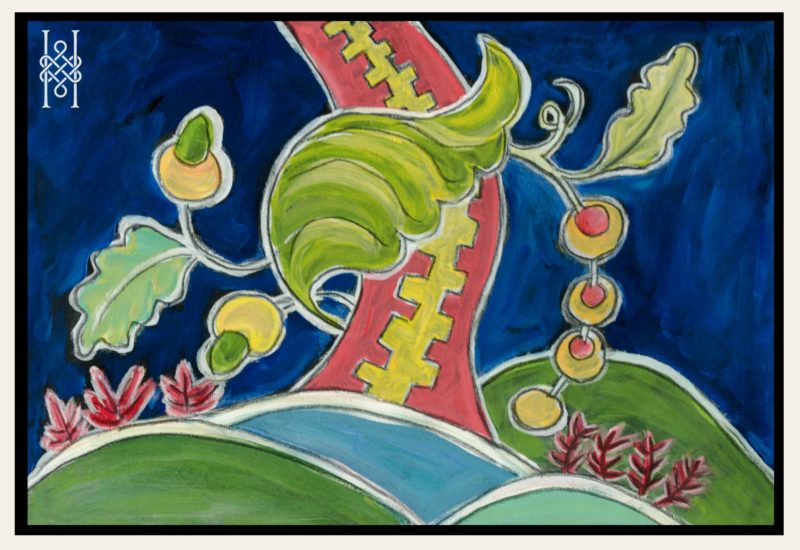
Jacobean Oak Tree
All the Tree of Life motifs discussed in my Post celebrate the tree and nature, and the same art ideas and symbols keep cropping up from the past and landing in the present.
As we write art history for tomorrow, we can choose which motifs and icons should have longevity and survive.
For me, the Tree of Life motif is a true and worthwhile symbol.
